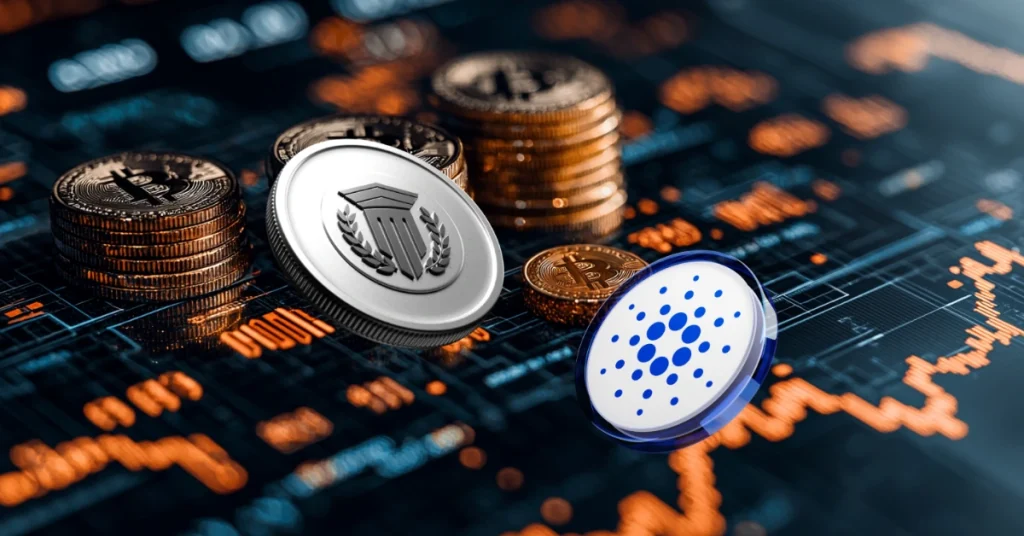Without specific regulation for blockchain payments, AI agents remain largely prototypes.
In this context, John D’Agostino, head of institutional strategy at Coinbase, recently reiterated this during an appearance on CNBC, emphasizing how blockchain represents a “source of truth” capable of enabling machine-to-machine executions and real-time payments.
According to public data from Chainalysis, updated in September 2025, on-chain activity and the use of stablecoins have grown significantly: for example, the monthly volume of EURC increased from about 47 million dollars in June 2024 to over 7.5 billion dollars in June 2025, indicating an acceleration of on-chain flows Chainalysis.
Industry analysts also note that the regulatory push is real: in the 2023 BIS survey, 94% of the central banks surveyed stated they are exploring CBDC projects, a key indicator of the changing regulatory landscape BIS.
The Point: Scalable AI and Blockchain as a Reliable Data Foundation
During a segment of Squawk Box, D’Agostino described AI as a form of “infinitely scalable intelligence,” describing blockchain as the “source of truth” that ensures its operation.
That said, the message is clear: if agents are to act on behalf of people, verifiable data and swift regulation are needed; otherwise, the system remains confined to prototype status, as is the case today for many cryptographic applications.
Why Real-Time is the Critical Threshold
Agents purchasing APIs, paying for microservices, or rebalancing positions must execute trades in milliseconds or a few seconds.
In fact, with slow networks, bots risk arbitrage, slippage, and other operational issues. The lack of near-instant finality significantly limits the automation of mission-critical flows.
Already Visible Use Cases
- DeFi Automation: bots executing strategies on smart contracts without the need for continuous supervision.
- M2M Payments: micro-payments between digital services, AI models, APIs, and storage systems.
- Supply chain and IoT: unlocking of assets or data upon reaching specific on-chain conditions.
Quick definitions: Smart contract is a program that automatically executes instructions on a blockchain when certain conditions are met. Instant settlement refers to a payment executed in a few seconds, with low risk of reversal.
Technical Comparison: Where We Stand on Latency and Costs
Performance varies significantly between networks and layers. It should be noted that the following values are indicative and may change based on congestion and protocol design (data updated as of October 2025):
In other words, truly autonomous agents require payment pipelines capable of finalizing transactions in a few seconds and with negligible costs.
In this direction, instant payment systems in the fiat world, such as FedNow, are also moving; however, the natively integrated programmability remains a strength of public networks.
Bitcoin in the architecture of agents: what really changes
In this context, D’Agostino avoids comparing Bitcoin with gold, instead highlighting its distinctive features: digitality, transferability, programmability, and the ability to build yield-oriented structures on higher levels.
In practice, Bitcoin can serve as both collateral and a unit of account for micro-payments, as well as a security anchor for second-layer protocols.
Market Factors to Watch
- Parked liquidity: the assets held in U.S. money markets exceed 4 trillion dollars Investment Company Institute, a figure that could be compared to the potential flow of money into digital assets.
- Rates and flows: in a context of declining yields, part of this liquidity might shift towards digital assets with an utility and an operational cash‑flow on‑chain, as a means to counter inflation and based on the policies of the Federal Reserve.
- Institutional products: maturity in custody, compliance, and risk management is essential to accelerate the adoption of crypto systems.
Institutional Adoption: A Gradual Path
D’Agostino calls for caution: pension funds, endowments, and sovereign funds do not move “in waves.” In fact, entry into this ecosystem occurs through specific mandates and with well-defined risk/return criteria.
To achieve this, fast settlement infrastructures, high custodial standards, and products capable of demonstrating a measurable utility are needed.
Checklist to unlock agents in production
- Instant transactions and rapid finality on L2 solutions, channels, or high-performance networks.
- Standard of compliance (KYC/AML) with integrated auditability.
- Mechanisms of security (limits, circuit breaker, policy-based controls) to manage autonomous actions.
Quick FAQ
Does AI-based automated trading already exist? Yes, bots and agents interact with protocols and exchange assets via smart contracts. However, scalability on a large scale depends on the ability to make fast, low-cost payments in a clear regulatory context.
Which networks are best suited for real-time? Solutions like Lightning channels and general-purpose rollups (L2) allow for reduced latency and fees. The final choice depends on factors such as costs, security, composability, and finality requirements.
Analysis: The Bottleneck is Not AI, It’s Regulation
AI is capable of making decisions in milliseconds. If a payment takes minutes or even hours, automation loses its competitive edge.
For this reason, Coinbase is focusing on the combination of AI + blockchain: verifiable data, programmable execution, and rapid settlement. Without these features, agents may appear as brilliant demos, but prove to be ineffective in production environments.
Source: https://en.cryptonomist.ch/2025/10/01/ai-agents-and-bitcoin-why-instant-crypto-payments-are-needed/


